Reclaimed table for climate action
Parched, weathered tree branches from Yemen. Wall panels charred by wildfires in Spain. Parts of a Ugandan home swept away by flooding. These are just some of the objects in a unique table, created by the IFRC, to represent the impact of climate-related disasters all over the world. On display at COP28, a section of the table is shown above. During the climate summit, it serves as a neutral space to come together and brainstorm about solutions. Below are the stories behind each part of the table, the people impacted and what’s being done to protect them in the future.
Germany
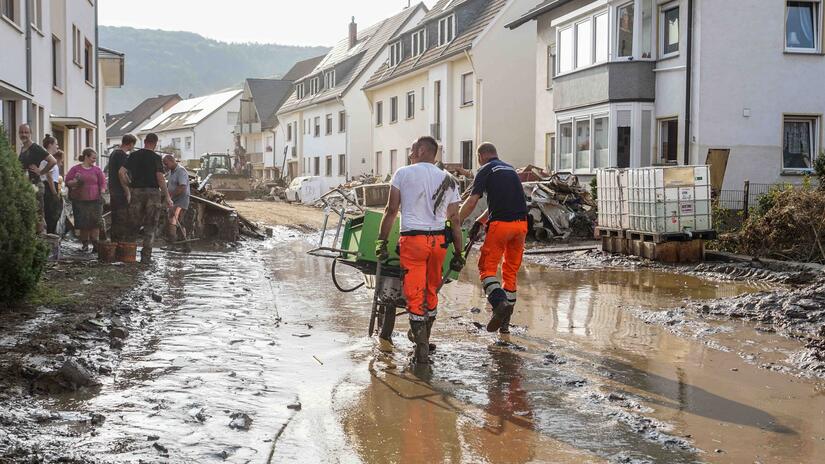
The German Red Cross responds after devastating floods in 2021.
Photo: German Red Cross
The light-blue section of an old door, with its rusty latch still in place, bears witness to the shocking devastation caused by unprecedented flooding that spanned across four German states in July 2021. Nearly 200 people were killed after torrents of water destroyed houses, bridges and other vital infrastructure, causing billions of euros in damage.
The aftermath of the tragedy – grieving families, lives and livelihoods destroyed, communities displaced – was by far the higher cost.
The German Red Cross responded immediately, performing search and rescue and supporting the survivors. Volunteers and staff remember the terrible events of July 2021 and they wonder: how will Germany – and the rest of the world – face the increasing frequency and intensity of climate-related disasters in the future.
Yemen
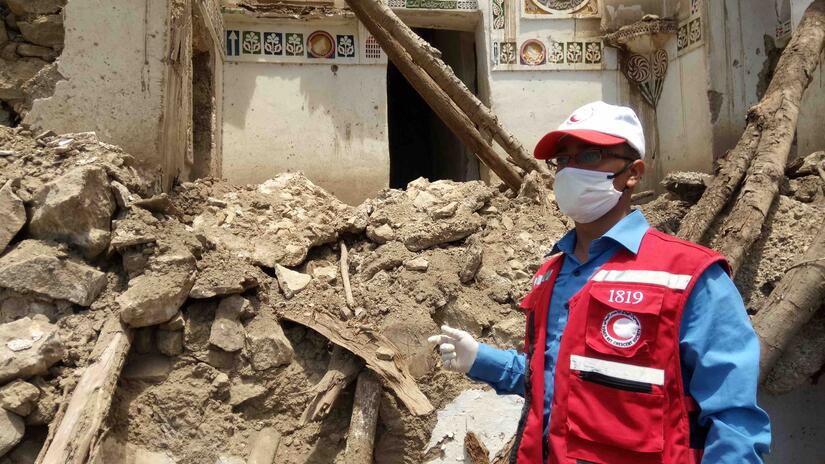
Yemen Red Crescent volunteers respond to drought on top of the impacts of protracted conflict.
Photo: Yemen Red Crescent
The parched tree branches from Yemen exemplify the deadly dual impact of drought and flash flooding. It’s a phenomenon more and more communities face as weather patterns become less predictable, while sun-baked soils become less able to absorb heavy rains.
These alternating phenomena come on top of nearly a decade of conflict, which has left more than two thirds of the country’s population in need of humanitarian assistance, 14 per cent of the population is internally displaced and more than 16 million face serious food insecurity.
In July 2022, a prolonged drought was followed by deadly flash flooding caused by heavy thunderstorms. More than 31,000 households suffered loss of life, homes or livelihoods.
The Yemen Red Crescent responded immediately to rescue survivors and provide healthcare and psychosocial support at 23 Red Crescent health centres.
Spain
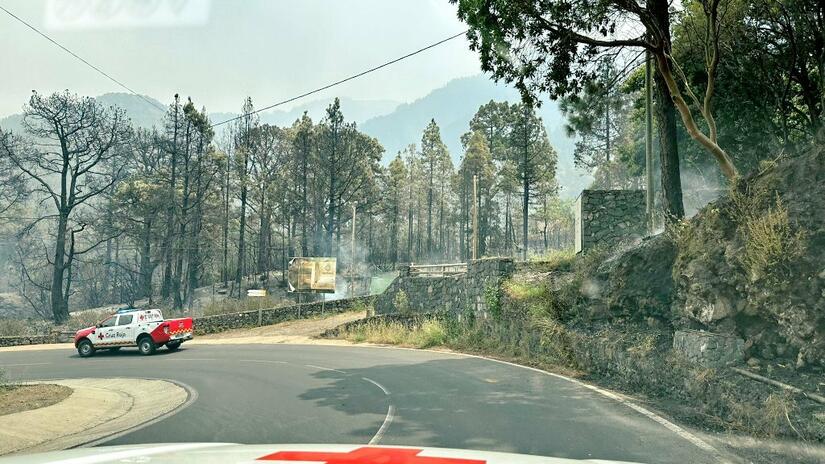
A Spanish Red Cross team arrives at the aftermath of wildfires.
Photo: Spanish Red Cross
An ocre-colored section of wall paneling, charred by wildfires in Spain, makes up another part of the table. The burnt wooden slats were singed by one of the wildfires that have proliferated across Spain due to intensive and increasingly frequent hot and dry spells.
Just this past August, a forest fire broke out on the Spanish island of Tenerife, in the Canary Islands. With temperatures high, humidity low and winds strong, the fire took hold and spread too quickly to be controlled.The blaze swiftly burned across 12 different municipalities, affecting some 14,600 hectares. More than 12,000 people were evacuated in a time of sheer terror for the communities affected.
The Spanish Red Cross worked around the clock to support the people affected by this terrifying event, as well as other similar fires around the country. They are still providing support today, including work to help communities reduce the risks of climate disasters.
Panama
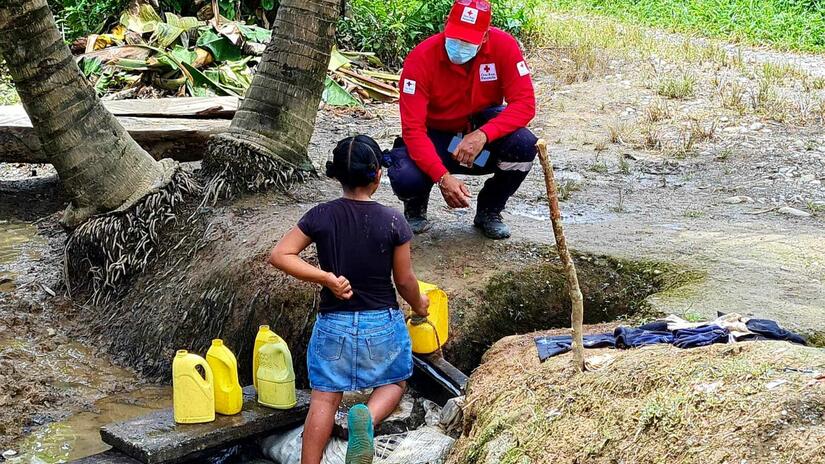
Panama Red Cross helps local communities with safe drinking water following heavy storms.
Photo: Panama Red Cross
The ceramic bottle placed in the center of the table contains water from catastrophic flooding that affected several provinces of Panama in November 2022. But it could have been taken from any number of floods in recent years.
Flood water is a multi-layered threat to human life. Even small amounts carry untreated human waste, pollutants and toxins that can spread life-threatening diseases. Panama is acutely vulnerable to floods and landslides, and their number and intensity continue to grow as the climate crisis worsens.
In 2022, the main rivers in three provinces burst their banks after days of torrential rain, destroying entire communities and contaminating water supplies. The previous year, heavy rain caused severe flooding across three western provinces, destroying homes, businesses, roads and bridges.
The Panama Red Cross is still supporting people who lost everything in these climate disasters – and working to build community resilience ahead of the next climate threat.
Italy
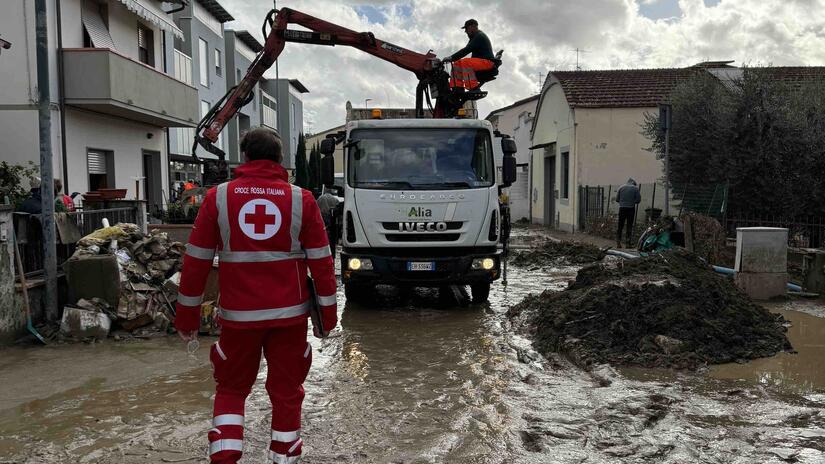
Italian Red Cross teams help dig out after a mudslide induced by heavy rains.
Photo: Italian Red Cross
At first glance, the sandals built into the center of the table may look any ordinary pair of children’s footwear. But for the Italian Red Cross, they symbolize a climate crisis that is putting countless lives at risk, often causing people to move long distances, within Italy and in other parts of the world.
Volunteers who welcome migrants often give them new shoes – a moment that is both a finish line and a new start.
But climate displacement is also a growing phenomenon within Italy. The country is prone to floods and landslides, while warming seas on both coasts make it increasingly vulnerable to powerful storms. In 2023, for example, severe flooding left 20,000 people homeless in northern Italian Emilia-Romagna region.
The Italian Red Cross works to support people forced to move in the face of the climate crisis, regardless of whether the displacement is short or long term, or whether it happens over great or small distances.
Syria
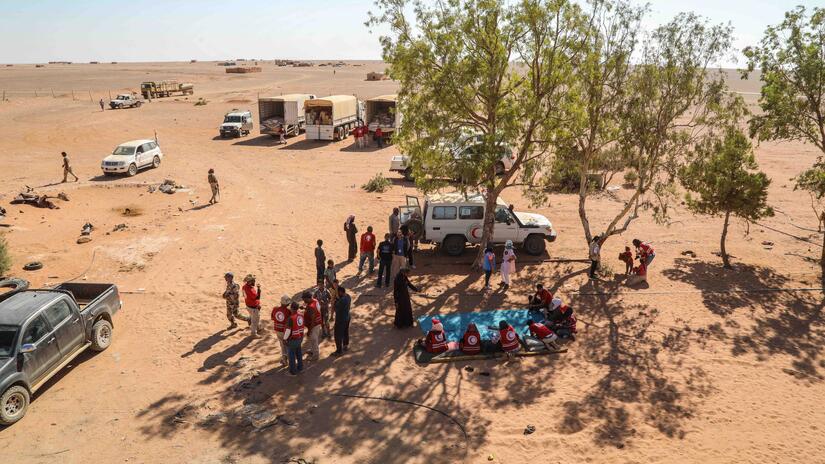
Extended drought and the aftermath of conflict put forests, crops and communities under great stress.
Photo: IFRC
The people of Syria have suffered conflict, displacement and disasters for more than a decade. This fragile environment is also being threatened by rising temperatures, long periods of drought and water shortages.
A combination of arid and semi-arid environments, only two per cent of the country’s total land mass is made up of forests (from which some of the wood in this table comes). But forests are not the only ecosystems under threat, as average temperatures in Syria have risen by 2°C in the past 100 years (roughly twice the global average). Most crops are rainfed in Syria and most wheat crops come from particularly drought-prone areas.
The Syrian Arab Red Crescent is working to reduce disaster risks and empower the most at-risk communities through programmes that jump-start new livelihoods and by promoting safe water, health and sanitation practices, among many other actions.
Uganda
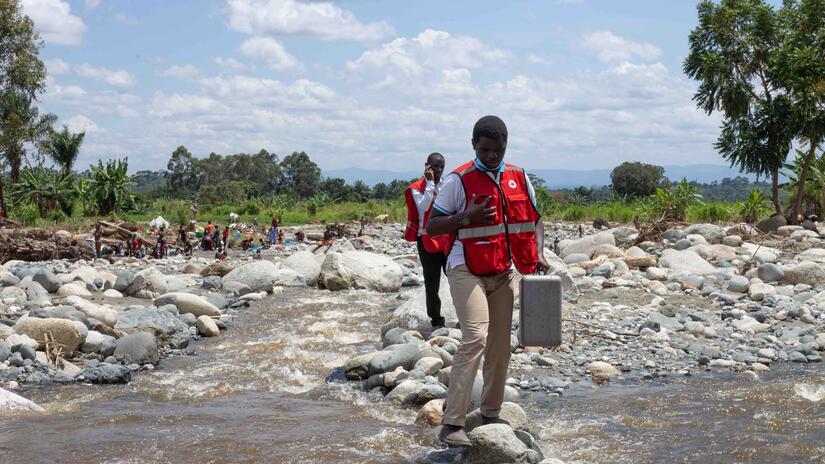
Uganda Red Cross teams reach out to remote mountainside villages after a series of floods and mudslides.
Photo: Ugandan Red Cross Society
In recent years, Uganda has been grappling with increasingly erratic rainfall. This has led to river overflows, mudslides and landslides that have devastated mountain-side communities. Low-lying areas have also faced recurring floods.
In the foothills around the western Ugandan city of Kisoro, for example, many thousands of people have been displaced by flooding and mudslides. Ugandan Red Cross teams arrived quickly to search for survivors and bodies of those killed. They helped people with shelter and provided water, health and hygiene support. The also worked with communities to clear waterways or bolster riverbanks to prevent future flooding.
In Eastern Uganda, the Uganda Red Cross Society started a campaign called "Fighting inequality for a resilient future. Let’s Break the Cycle!" Staff and volunteers distributed 1,500 Grevillea Robusta tree seedlings to communities in the flood and landslide-prone regions to reduce the risk of mudslides and to control runoff.
A global threat: Island nations holding on against the tide
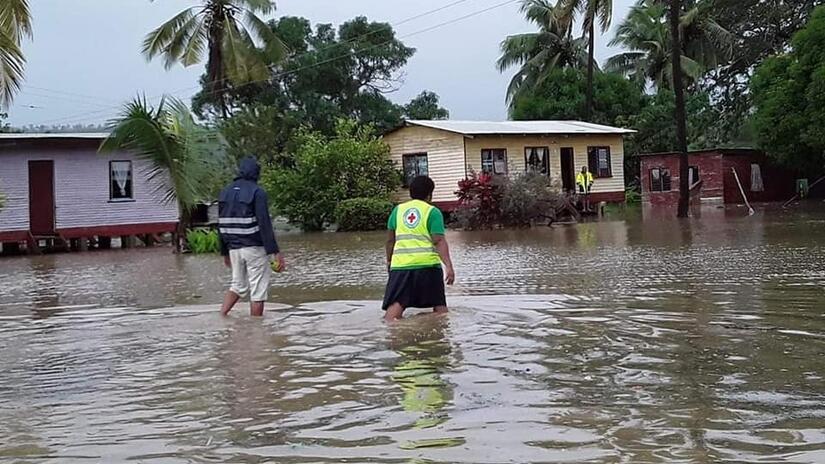
Fiji Red Cross volunteer wades in to help communities hit by storm surges and rising tides.
Photo: Fiji Red Cross Society
People who gather around the table will notice there is a section missing. This is not an ovrersight. This missing section represents the many climate-related disasters not represented by a specific object or piece of debris in the table. Consider the case of Fiji – and other Small Island Developing States.
While these islands do not have an artifact built into the table, they have suffered acutely from intensified weather events such as cyclones, flooding, extreme heat and rising sea levels. In fact, Fiji and other Pacific islands are under existential threat. If urgent action is not taken to curb the climate crisis, they may cease to exist altogether.
The Red Cross and Red Crescent works every day to help communities reduce the risks of climate disasters, and to keep people safe and healthy. Only concerted international action can hold back the tide that threatens to destroy communities facing existential threats due to the climate crisis.
